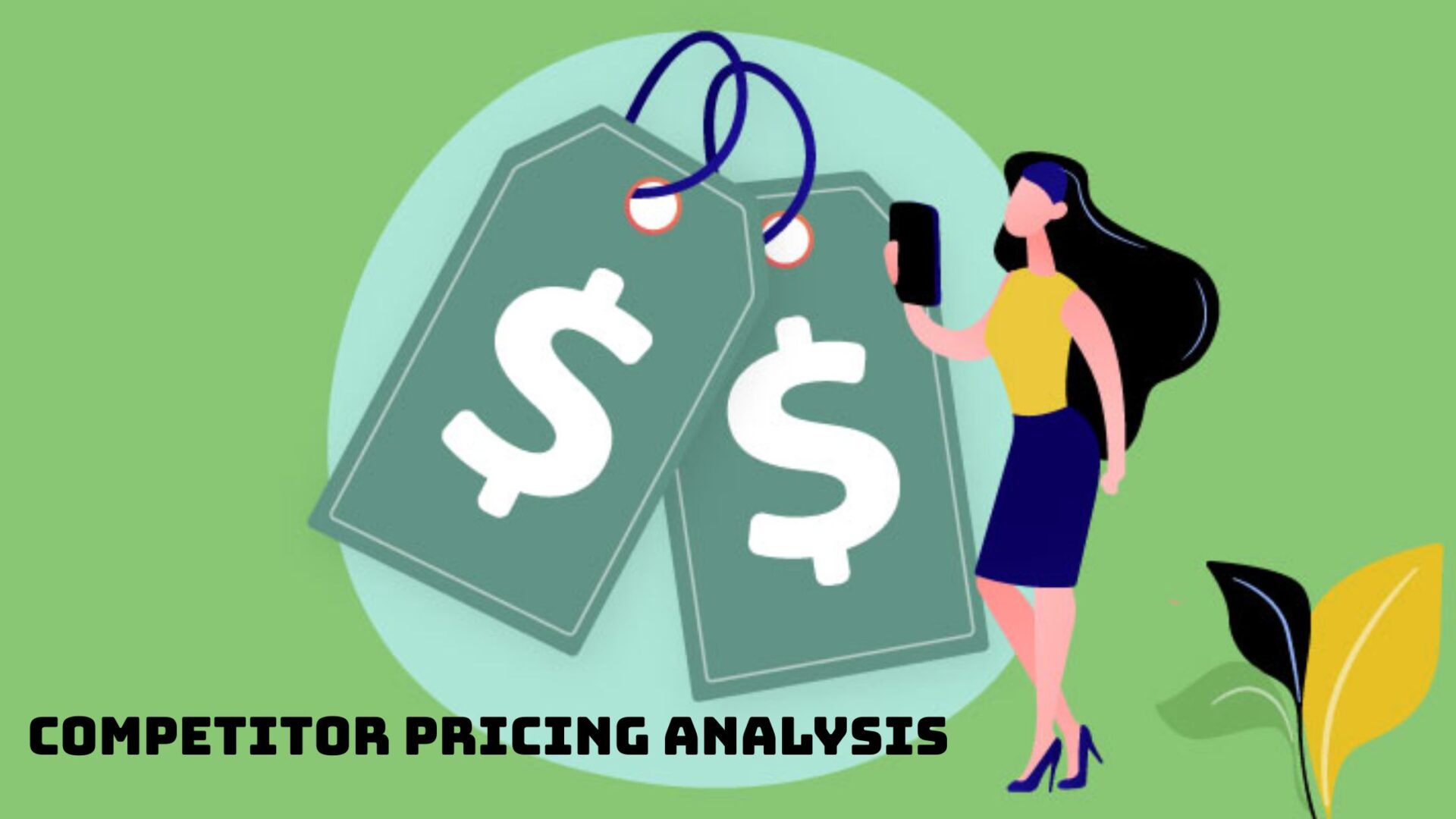Imagine your business offers a fantastic product, yet, sales figures aren’t quite where you expect them to be. You might be overpricing, causing customers to choose your competitors, resulting in lost sales and stagnant growth. Conversely, you could be underpricing, leaving valuable profit on the table and potentially devaluing your offering in the eyes of your target market.
This article will discuss Competitor Pricing Analysis. We will explore why understanding how your competitors price their products or services is not just a good idea, but a fundamental business growth and robust profitability. Practical strategies to leverage this information to your advantage, ultimately positioning your business for greater success in the market.
1. What is Competitor Pricing Analysis?
In global marketplace, setting the right price for what you sell is a difficult task. It’s about understanding not just what prices your competitors use, but also why they use those prices and how this affects your own business decisions and overall success.
Understanding Competitor Pricing Analysis
Simply put, Competitor Pricing Analysis is when you collect, organize, and understand information about the prices of similar things your competitors sell. A full analysis looks at different parts of their pricing methods, like how they decide their prices (for example, adding a profit to their costs, pricing based on what customers think it’s worth, or changing prices depending on the situation), any discounts or special offers they have, how people pay, and even how valuable customers think their product is.
While understanding your customers and the market is important, even more crucial for making profitable pricing decisions and ensuring long-term competitiveness and growth is analyzing how your competitors demonstrate their value through their prices. This analysis provides invaluable insights that directly inform your own pricing strategy.
The Components of Competitor Pricing Analysis
A careful competitor analysis market pricing strategy has several important parts that work together to give you a full picture of the prices in your market. These parts include:
- Finding Your Main Competitors: This might seem easy, but it’s important to think about both direct competitors (those selling very similar things to the same people you are) and indirect competitors (those selling different things that could still meet the same needs for customers).
- Getting Price Information: Once you know who your main competitors are, the next step is to get their price information. You can do this in different ways, such as: Checking Yourself, Using Price Tracking Tools, Looking at Public Information.
- Discount and Promotional Strategies: This could include seasonal sales, percentage discounts, buy-one-get-one-free deals, or special offers for new customers. Looking at how your competitors’ prices have changed over time can show you patterns in their pricing methods.
- Value Proposition Comparison: This goes beyond just price. You need to compare what customers get for the price they pay from you versus your competitors. This includes the quality of the product or service, any extra features, the level of customer support, and the overall brand reputation.
- Comparing Prices: Once you have collected and understood the price information, the next step is to compare it to your own prices. You need to look at the basic price but also consider any variations based on features, quality, or quantity. This comparison can help you see if your prices are too high, too low, or about right compared to the market.
- Shipping and Delivery Costs: For businesses that sell physical products, the cost of shipping and delivery can be a significant factor for customers.
2. Why Do Businesses Need Competitor Pricing Analysis?
Price comparison analysis acts as an important compass guiding businesses toward effective pricing strategies. By embracing this practice, businesses can make informed pricing decisions that contribute directly to their growth, profitability, and long-term sustainability.
Staying Competitive in the Market
The market is always changing, and competitors change their prices for different reasons, like if more or fewer people want their products, if their costs go up or down, or if they have a new plan. So, regularly watching and competitor price tracking is important to stay informed and change your own competitive pricing strategy when needed.
If a business consistently prices its products or services significantly higher than its competitors without a clear and justifiable difference in value MVP (e.g., superior quality, exceptional customer service), they risk losing potential customers. Conversely, underpricing might attract customers in the short term, but it can also lead to lower profit margins, making it difficult to reinvest in the business, innovate, and sustain long-term growth. Furthermore, extremely low prices can sometimes create a perception of lower quality in the minds of consumers.
Understanding Customer Expectations and Market Trends
Beyond simply matching or beating competitor prices, Competitor Pricing Analysis provides valuable insights into understanding customer expectations and market trends. By observing the pricing strategies of their competitors, businesses can gain a better understanding of the perceived value of different offerings in the eyes of their shared customer base.
Competitor pricing analysis allows businesses to stay informed about what customers expect in terms of price and what they’re willing to pay. If multiple competitors are consistently pricing a certain type of product within a specific range, it indicates that this is the price point that the market has generally accepted as fair and reasonable. For example, there were instances of significant price increases, with N95 masks being offered to hospitals for as much as $11.95 per mask, compared to the pre-pandemic price range of approximately $0.44 to $0.70 per respirator.
Adjusting to Dynamic Market Conditions
To continuously adjust pricing strategies based on new market trends and pricing.
By regularly monitoring competitor pricing, businesses can quickly identify changes in the competitive landscape and respond appropriately. This might involve adjusting their own prices, launching counter-promotions, or re-evaluating their value proposition to maintain their competitive edge.
Market conditions and competitor actions can change rapidly. Without regular competitor pricing analysis, businesses may fall behind. A competitor might suddenly launch a significant price promotion, a new entrant might offer aggressively low prices to gain market share, or an established player might adjust their pricing strategy in response to changing costs or demand.
3. The Benefits of Competitor Pricing Analysis for Businesses
Competitor Pricing Analysis emerges as a powerful tool, offering a multitude of benefits that can steer businesses towards greater success. Companies can unlock valuable insights that inform critical decisions across various aspects of their operations.
Optimizing Pricing Strategies
Setting the right price is a delicate balance, and understanding what competitors are doing provides essential context, ultimately contributing to the business’s ability to cover its operational costs and maintain sustainability. Without this knowledge, businesses risk either overpricing, leading to lost sales, or underpricing, which can erode profit margins and potentially devalue their brand, hindering their capacity to meet ongoing expenses. Businesses can determine the most effective price points for their own products/services, maximizing revenue while ensuring they can adequately fund their operations and maintain competitiveness.
Enhancing Profit Margins
By aligning pricing strategies with competitors’ but optimizing the value proposition (e.g., product quality, service, or delivery), businesses can potentially increase their margins without sacrificing customer demand. Conversely, if Competitor Pricing Analysis reveals that competitors are offering similar products at lower prices, it might prompt a business to re-evaluate its cost structure and identify areas where efficiencies can be made. Research from Simon Kucher & Partners, indicates that companies that conduct thorough price research, including competitor analysis, are 27% more profitable on new product launches.
Improving Marketing and Promotional Decisions
The benefits of Competitor Pricing Analysis extend beyond just setting the base price. It also plays a crucial role in improving decisions on discounts, offers, and promotional pricing, which improves marketing ROI. By understanding the competitive landscape of marketing and promotions, businesses can craft more effective messages and offers that resonate with their target audience and stand out from the crowd.
Building Customer Loyalty and Trust
AI for market research is a game-changer for businesses seeking to improve their marketing strategies. Leveraging AI for Market Research isn’t just an option—it’s a competitive necessity. Whether you’re aiming to decode consumer trends, anticipate market shifts, or outpace competitors, AI unlocks powerful insights that traditional methods simply can’t match. With strategic guidance from experts like GODI, your business can confidently turn AI-driven insights into actionable strategies.
Reducing Risks and Enhancing Decision Making
Finally, Competitor Pricing Analysis plays a vital role in reducing risks and enhancing decision making across various aspects of a business. A well-conducted competitor pricing analysis reduces the risk of pricing mistakes and provides businesses with data to support decisions. According to a study by Harvard Business Review, pricing mistakes are a leading cause of new product failure, with some estimates suggesting that as many as 80% of new products fail, and incorrect pricing is a significant contributing factor in many of these cases.
4. How to Leverage Competitor Pricing Analysis for Business Growth
Competitor Pricing Analysis is not just about knowing what your rivals are charging,it’s a planned tool that, when used well, can be a strong way for your business to grow.
Regularly Track and Adjust Your Pricing
One of the most basic ways to use Competitor Pricing Analysis for business growth is to regularly watch and change your pricing. Make sure that competitor pricing analysis is something you do all the time to keep your prices in line with what’s happening in the market and what your competitors are doing.
If your prices stay the same while competitors are giving discounts or lowering their main prices, you might lose customers who are very focused on price. On the other hand, if your prices are much lower than the market without a good reason, you might be missing out on making more profit. Once you have this information, the important step is to change your pricing in a planned way.
- Matching Competitors: If what you sell is similar to what your competitors sell, setting your prices at the same level can help you stay competitive and attract customers who are mainly looking at price.
- Pricing Based on Value: If you offer better quality, more features, or better customer service, you might be able to charge a slightly higher price. Competitor Pricing Analysis can help you see how much more customers are willing to pay for these extra benefits.
- Pricing to Enter the Market: If you are selling a new product or starting in a new market, you might choose to set your prices lower than your competitors at first to get more customers. Competitor Pricing Analysis gives you a standard for setting these starting prices well.
- Pricing High at First: For new or unique products where there aren’t many competitors at first, you might use a strategy of setting a high price that early customers are willing to pay. When more competitors start selling similar things, you can then slowly lower your price, based on what their prices are.
Integrate Competitor Pricing Data with Other Business Strategies
The usefulness of Competitor Pricing Analysis becomes even greater when you use what you learn from it together with your other important business plans.
- Marketing Strategy: Analyze how your competitors position their prices in their marketing materials and digital marketing strategy. Do they emphasize being the cheapest, the most premium, or the best value for money? What language do they use? Where do they advertise?
- Sales Strategy: Train your sales team to confidently address customer concerns about price by highlighting your product’s unique benefits and value compared to competitors. This could focus on better quality materials, superior customer support, faster delivery, or a longer warranty.
- Product Development Strategy: Analyze the features and quality of competitors’ products in relation to their prices. Identify any gaps or unmet needs in the market that are not being addressed by the current pricing landscape.
- Customer Service Strategy: Understand that customers’ perception of price is often linked to their expectations of service. Pay attention to what customers are saying about competitors’ pricing and service. This can highlight areas where you can differentiate yourself through superior service, even if your prices are similar.
5. Conclusion:
Competitor Pricing Analysis is a really important way for any business that wants to do well and grow in today’s market. By carefully understanding and changing their prices in a planned way based on what other businesses are doing, companies can make sure their prices are just right and make more profit.
Looking at what competitors charge helps businesses set the right price and stay able to compete in a market where there are many choices. If businesses want help from experts with this, they can think about using companies that help with online marketing, like GODI. They can give helpful assistance in making your prices and online selling plans as good as possible for success that lasts. Companies can make better choices about their special offers online, how much money to spend on ads, and how to show their business in the best way online.
Once your pricing strategy aligns with market expectations, the next challenge is filling your funnel. Our expert-backed guide on SaaS lead generation outlines powerful tactics to attract and convert qualified leads for scalable growth.







